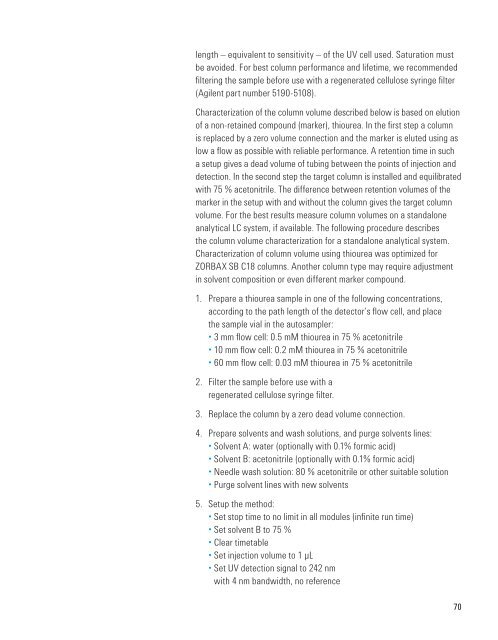Principles and Practical Aspects of Preparative Liquid Chromatography
Create successful ePaper yourself
Turn your PDF publications into a flip-book with our unique Google optimized e-Paper software.
length – equivalent to sensitivity – <strong>of</strong> the UV cell used. Saturation must<br />
be avoided. For best column performance <strong>and</strong> lifetime, we recommended<br />
filtering the sample before use with a regenerated cellulose syringe filter<br />
(Agilent part number 5190-5108).<br />
Characterization <strong>of</strong> the column volume described below is based on elution<br />
<strong>of</strong> a non-retained compound (marker), thiourea. In the first step a column<br />
is replaced by a zero volume connection <strong>and</strong> the marker is eluted using as<br />
low a flow as possible with reliable performance. A retention time in such<br />
a setup gives a dead volume <strong>of</strong> tubing between the points <strong>of</strong> injection <strong>and</strong><br />
detection. In the second step the target column is installed <strong>and</strong> equilibrated<br />
with 75 % acetonitrile. The difference between retention volumes <strong>of</strong> the<br />
marker in the setup with <strong>and</strong> without the column gives the target column<br />
volume. For the best results measure column volumes on a st<strong>and</strong>alone<br />
analytical LC system, if available. The following procedure describes<br />
the column volume characterization for a st<strong>and</strong>alone analytical system.<br />
Characterization <strong>of</strong> column volume using thiourea was optimized for<br />
ZORBAX SB C18 columns. Another column type may require adjustment<br />
in solvent composition or even different marker compound.<br />
1. Prepare a thiourea sample in one <strong>of</strong> the following concentrations,<br />
according to the path length <strong>of</strong> the detector’s flow cell, <strong>and</strong> place<br />
the sample vial in the autosampler:<br />
• 3 mm flow cell: 0.5 mM thiourea in 75 % acetonitrile<br />
• 10 mm flow cell: 0.2 mM thiourea in 75 % acetonitrile<br />
• 60 mm flow cell: 0.03 mM thiourea in 75 % acetonitrile<br />
2. Filter the sample before use with a<br />
regenerated cellulose syringe filter.<br />
3. Replace the column by a zero dead volume connection.<br />
4. Prepare solvents <strong>and</strong> wash solutions, <strong>and</strong> purge solvents lines:<br />
• Solvent A: water (optionally with 0.1% formic acid)<br />
• Solvent B: acetonitrile (optionally with 0.1% formic acid)<br />
• Needle wash solution: 80 % acetonitrile or other suitable solution<br />
• Purge solvent lines with new solvents<br />
5. Setup the method:<br />
• Set stop time to no limit in all modules (infinite run time)<br />
• Set solvent B to 75 %<br />
• Clear timetable<br />
• Set injection volume to 1 µL<br />
• Set UV detection signal to 242 nm<br />
with 4 nm b<strong>and</strong>width, no reference<br />
70



